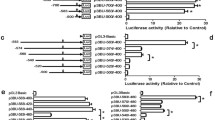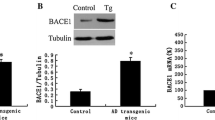Abstract
The amyloid-β (Aβ) peptide, the proteolytic fragment of Aβ precursor protein (APP), aggregates and forms neuritic plaques, a major hallmark of Alzheimer's disease (AD). The limiting step in generating the Aβ peptide from APP is cleavage by the β-secretase enzyme, BACE1. Regulation of the BACE1 gene is likely to play an important role in AD etiology and treatment. We therefore studied the activity of a 4.1-kb 5′-flanking region (−3765/+364, +1 being the transcription start site) of the BACE1 gene, both in 5′- and 3′-deletion series and through Northern blotting. We show that the BACE1 promoter has regulatory activity throughout the 4.1-kb length, both positive and negative, and that this activity can be quantitatively modeled according to promoter sequence length, with the specific model depending on the presence of negative regulatory elements as the 5′-most portion of the sequence. We also examined a previously identified 141-bp proximal fragment (+224/+364) of the BACE1 promoter and two constituent (91- and 50-bp) subfragments. We report that the 91-bp fragment (+224/+314) is the most likely seat of neuronal expression of the BACE1 gene and that it is the portion of the 141-bp fragment that accounts for observed DNA-protein interactions in brain extracts. The 50-bp fragment (+315/+364), which showed significant reporter gene activity from the empty vector, binds nuclear proteins in a cell type-specific manner and contains the AP2 site as shown by the electrophoretic mobility shift assay. Overall, the 141-bp fragment had no strong matches within GenBank, and the 91-bp fragment is predicted to have several potential stem-loop sites. Taken together, BACE1 gene promoter activity is differentially regulated, and the 91-bp fragment represents a novel promoter region for cell type-specific regulation. This fragment might be a useful target to regulate BACE1 expression leading to Aβ production and to understand the neuropathogenesis of AD.
Similar content being viewed by others
References
Acquati F., Accarino M., Nucci C., Fumagalli P., Jovine L., Ottolenghi S., and Taramelli R. (2000) The gene encoding DRAP (BACE2), a glycosylated transmembrane protein of the aspartic protease family, maps to the down critical region. FEBS Lett. 468, 59–64.
Asai M., Hattori C., Szabo B., Sasagawa N., Maruyama K., Tanuma S., and Ishiura S. (2003) Putative function of ADAM9, ADAM10, and ADAM17 as APP α-secretase. Biochem. Biophys. Res. Commun. 301, 231–235.
Barbiero L., Benussi L., Ghidoni R., Alberici A., Russo C., Schettini G., et al. (2003) BACE-2 is overexpressed in Down's syndrome. Exp. Neurol. 182, 335–345.
Bargou R. C. and Leube R. E. (1991) The synaptophysin-encoding gene in rat and man is specifically transcribed in neuroendocrine cells. Gene 99, 197–204.
Bennett B. D., Babu-Khan S., Loeloff R., Louis J. C., Curran E., Citron M., and Vassar R. (2000) Expression analysis of BACE2 in brain and peripheral tissues. J. Biol. Chem. 275, 20,647–20,651.
Benson D. A., Karsch-Mizrachi I., Lipman D. J., Ostell J., and Wheeler D. L. (2006) GenBank. Nucleic Acids Res. 34, D16-D20.
Christensen M.A., Zhou W., Qing H., Lehman A., Philipsen S., and Song W. (2004) Transcriptional regulation of BACE1 the β-amyloid precursor protein β-secretase, by Sp1. Mol. Cell. Biol. 24, 865–874.
Clarimon J., Bertranpetit J., Galafell F., Boada M., Tarraga L., and Comas D. (2003) Association study between Alzheimer's disease and genes involved in Aβ biosynthesis, aggregation and degradation: suggestive results with BACE1. J. Neurol. 250, 956–961.
De Pietri Tonelli D., Mihailovich M., Di Cesare A., Codazzi F., Grohovaz F., and Zacchetti D. (2004) Translational regulation of BACE-1 expression in neuronal and nonneuronal cells. Nucleic Acids Res. 32, 1808–1817.
Ehehalt R., Michel B., De Pietri Tonelli D., Zacchetti D., Simons K., and Keller P. (2002) Splice variants of the β-site APP-cleaving enzyme BACE1 in human brain and pancreas. Biochem. Biophys. Res. Commun. 293, 30–37.
Farzan M., Schnitzler C. E., Vasilieva N., Leung D., and Choe H. (2000) BACE2, a β-secretase homolog, cleaves at the β site and within the amyloid-β region of the amyloid-β precursor protein. Proc. Natl. Acad. Sci. U. S. A. 97, 9712–9717.
Ge Y. W., Maloney B., Sambamurti K., and Lahiri D. K. (2004) Functional characterization of the 5′ flanking region of the BACE gene: identification of a 91 bp fragment involved in basal level of BACE promoter expression. FASEB J. 18, 1037–1039.
Ghosh C., Song W., and Lahiri D. K. (2000) Efficient DNA transfection in neuronal and astrocytic cell lines. Mol. Biol. Rep. 27, 113–121.
Gold G., Blouin J. L., Herrmann F. R., Michon A., Mulligan R., Duriaux Sail G., et al. (2003) Specific BACE1 genotypes provide additional risk for late-onset Alzheimer disease in APOEε4 carriers. Am. J. Med. Genet. 119B, 44–47.
Hardy J. and Selkoe D. J. (2002) The amyloid hypothesis of Alzheimer's disease: progress and problems on the road to therapeutics. Science 297, 353–356.
Hartmann T., Bieger S. C., Bruhl B., Tienari P. J., Ida N., Allsop D., et al. (1997) Distinct sites of intracellular production for Alzheimer's disease Aβ40/42 amyloid peptides. Nat. Med. 3, 1016–1020.
Hussain I., Powell D., Howlett D. R., Tew D. G., Meek T. D., Chapman C., et al. (1999) Identification of a novel aspartic protease (Asp 2) as β-secretase. Mol. Cell. Neurosci. 14, 419–427.
Isacson O., Seo H., Lin L., Albeck D., and Granholm A. C. (2002) Alzheimer's disease and Down's syndrome: roles of APP, trophic factors and ACh. Trends Neurosci. 25, 79–84.
Jacobs G. H., Rackham O., Stockwell P. A., Tate W., and Brown C. M. (2002) Transterm: a database of mRNAs and translational control elements. Nucleic Acids Res. 30, 310–311.
Kitazume S., Nakagawa K., Oka R., Tachida Y., Ogawa K., Luo Y., et al. (2005) In vivo cleavage of α2,6-sialyltransferase by Alzheimer βsecretase. J. Biol. Chem. 280, 8589–8595.
La Fauci G., Lahiri D. K., Salton S. R. and Robakis N. K. (1989) Characterization of the 5′-end region and the first two exons of the βprotein precursor gene. Biochem. Biophys. Res. Commun. 159, 297–304.
Lahiri D. K. (2004) Unraveling nature's secrets, from neurons and memory to brain disorders: exploring the new frontier of Alzheimer's disease. Curr. Alz. Res. 1, 1.
Lahiri D. K., Alley G. M., Ge Y. W., and Du Y. (2002) Functional characterization of the 5′-regulatory region of the murine apolipoprotein gene. Ann. N. Y. Acad. Sci. 973, 340–344.
Lahiri D. K. and Robakis N. K. (1991) The promoter activity of the gene encoding Alzheimer βamyloid precursor protein (APP) is regulated by two blocks of upstream sequences. Brain Res. Mol. Brain Res. 9, 253–257.
Lahiri D. K., Farlow M. R., Sambamurti K., Greig N. H., Giacobini E., and Schneider L. S. (2003) A critical analysis of new molecular targets and strategies for drug developments in Alzheimer's disease. Curr. Drug Targets 4, 97–112.
Lahiri D. K., Maloney B., and Ge Y.-W. (2006) Functional domains of the BACE1 and BACE2 promoters and mechanisms of transcriptional suppression of the BACE2 promoter in normal neuronal cells. J. Mol. Neurosci. 29(1), in press.
Lahiri D. K., Ge Y.-W., and Maloney B. (2005a) Characterization of the APP proximal promoter and 5′-untranslated regions: identification of cell-type specific domains and implications in APP gene expression and Alzheimer's disease. FASEB J. 19, 653–655.
Lahiri D. K., Wavrant De-Vrieze F., Ge Y.-W., Maloney B., and Hardy J. (2005b) Characterization of two APP gene promoter polymorphisms that appear to influence risk of late-onset Alzheimer's disease. Neurobiol. Aging 26, 1329–1341.
Lahiri D. K., Xu Y., Klaunig J., Baiyewu O., Ogunniyi A., Hall K., et al. (1999) Effect of oxidative stress on DNA damage and βamyloid precursor proteins in lymphoblastoid cell lines from a Nigerian population. Ann. N. Y. Acad. Sci. 893, 331–336.
Ling Y., Morgan K., and Kalsheker N. (2003) Amyloid precursor protein (APP) and the biology of proteolytic processing: relevance to Alzheimer's disease. Int. J. Biochem. Cell. Biol. 35, 1505–1535.
Luckow B. and Schutz G. (1987) CAT constructions with multiple unique restriction sites for the functional analysis of eukaryotic promoters and regulatory elements. Nucleic Acids Res. 15, 5490.
Maloney B., Ge Y. W., Greig N., and Lahiri D. K. (2004) Presence of a “CAGA box” in the APP gene unique to amyloid plaque-forming species and absent in all APLP-1/2 genes: implications in Alzheimer's disease. FASEB J. 18, 1288–1290.
Motonaga K., Itoh M., Becker L.E., Goto Y., and Takashima S. (2002) Elevated expression of β-site amyloid precursor protein cleaving enzyme 2 in brains of patients with Down syndrome. Neurosci. Lett. 326, 64–66.
Ohno M., Sametsky E. A., Younkin L. H., Oakley H., Younkin S. G., Citron M., et al. (2004) BACE1 deficiency rescues memory deficits and cholinergic dysfunction in a mouse model of Alzheimer's disease. Neuron 41, 27–33.
Prasher V. P., Farrer M. J., Kessling A. M., Fisher E. M., West R. J., Barber P. C., and Butler A. C. (1998) Molecular mapping of Alzheimer-type dementia in Down's syndrome. Ann. Neurol. 43, 380–383.
Salbaum J. M., Weidemann A., Lemaire H. G., Masters C. L., and Beyreuther K. (1988) The promoter of Alzheimer's disease amyloid A4 precursor gene. EMBO J. 7, 2807–2813.
Sambamurti K., Kinsey R., Maloney B., Ge Y.W., and Lahiri D.K. (2004) Gene structure and organization of the human βsecretase (BACE) promoter. FASEB J 18, 1034–1036.
Satoh J. and Kuroda Y. (2000) Amyloid precursor protein β-secretase (BACE) mRNA expression in human neural cell lines following induction of neuronal differentiation and exposure to cytokines and growth factors. Neuropathology 20, 289–296.
Sauerwald A., Hoesche C., Oschwald R., and Kilimann M. W. (1990) The 5′-flanking region of the synapsin I gene. AG+C-rich, TATA- and CAAT-less, phylogenetically conserved sequence with cell type-specific promoter function. J. Biol. Chem. 265, 14,932–14,937.
Selkoe D.J. (2003) Aging, amyloid, and Alzheimer's disease: a perspective in honor of Carl Cotman. Neurochem. Res. 28, 1705–1713.
Selkoe D. J. (2004) Alzheimer disease: mechanistic understanding predicts novel therapies. Ann. Intern. Med. 140, 627–638.
Sinha S., Anderson J. P., Barbour R., Basi G. S., Caccavello R., Davis D., et al. (1999) Purification and cloning of amyloid precursor protein β-secretase from human brain. Nature 402, 537–540.
Solans A., Estivill X., and de La Luna S. (2000) A new aspartyl protease on 21q22.3, BACE2, is highly similar to Alzheimer's amyloid precursor protein β-secretase. Cytogenet. Cell Genet. 89, 177–184.
Song W. and Lahiri D. K. (1998) Functional identification of the promoter of the gene encoding the Rhesus monkey β-amyloid precursor protein. Gene 217, 165–176.
Strausberg R. L., Feingold E. A., Grouse L. H., Derge J. G., Klausner R. D., Collins F. S., et al. (2002), Generation and initial analysis of more than 15,000 full-length human and mouse cDNA sequences. Proc. Natl. Acad. Sci. U. S. A. 99, 16,899–16,903.
Tanahashi H. and Tabira T. (2001) Three novel alternatively spliced isoforms of the human β-site amyloid precursor protein cleaving enzyme (BACE) and their effect on amyloid β-peptide production. Neurosci. Lett. 307, 9–12.
Thiel G., Greengard P., and Sudhof T. C. (1991) Characterization of tissue-specific transcription by the human synapsin I gene promoter. Proc. Natl. Acad. Sci. U. S. A. 88, 3431–3435.
Vassar R., Bennett B. D., Babu-Khan S., Kahn S., Mendiaz E. A., Denis P., et al. (1999) β-Secretase cleavage of Alzheimer's amyloid precursor protein by the transmembrane aspartic protease BACE. Science 286, 735–741.
Yan R., Bienkowski M. J., Shuck M. E., Miao H., Tory M. C., Pauley A. M., et al. (1999) Membrane-anchored aspartyl protease with Alzheimer's disease β-secretase activity. Nature 402, 533–537.
Author information
Authors and Affiliations
Corresponding author
Rights and permissions
About this article
Cite this article
Lahiri, D.K., Maloney, B. & Ge, YW. BACE1 gene promoter is differentially regulated. J Mol Neurosci 28, 193–210 (2006). https://doi.org/10.1385/JMN:28:2:193
Received:
Accepted:
Issue Date:
DOI: https://doi.org/10.1385/JMN:28:2:193




